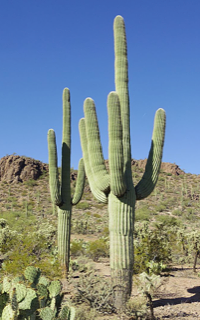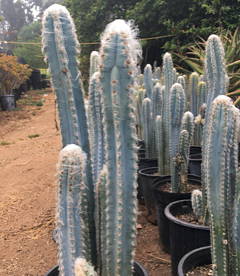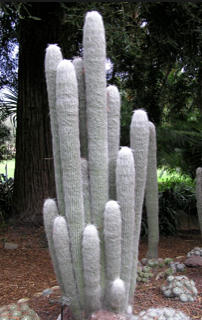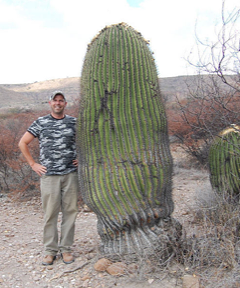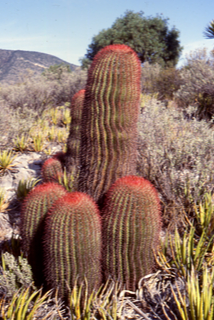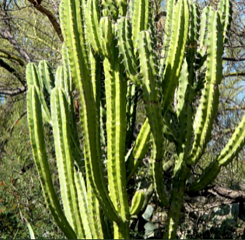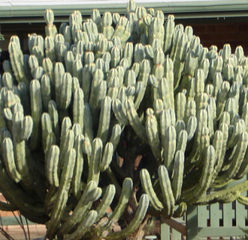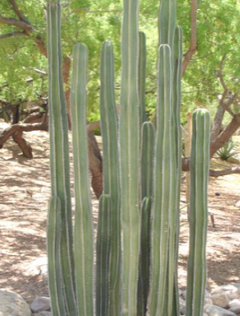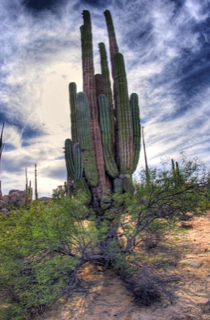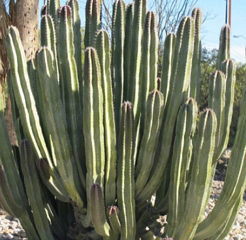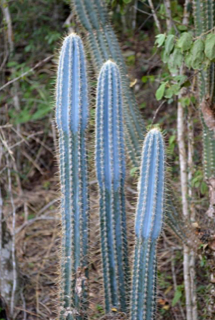Submitted by: Jim Tanner
Cacti show a wide variety of growth habits, this month’s plant is North American Columnar Cacti.
Some cacti may become tree-sized but without branches, such as larger specimens of Echinocactus platyacanthus. Cacti may also be described as shrubby, with several stems coming from the ground or from branches very low down, such as in Stenocereus thurberi.
Smaller than the tree-like (arborescent) cacti may be described as columnar. They consist of erect, cylinder-shaped stems, which may or may not branch, without a very clear division into trunk and branches. The boundary between columnar forms and tree-like or shrubby forms is difficult to define. Smaller and younger specimens of Cephalocereus senilis, for example, are columnar, whereas older and larger specimens may become tree-like. In some cases, the “columns” may be horizontal rather than vertical. Thus, Stenocereus eruca has stems growing along the ground, rooting at intervals.
LATIN LOOKUP – Loquerisne Latine (Do you speak Latin)?
The meanings of latin plant names on this page – from http://davesgarden.com/guides/botanary/
- Cephalocereus [sef-uh-low-KER-ee-us, sef-uh-low-SER-ee-us]
From the Greek kephale (head) and Cereus (a genus of cactus), referring to the woolly head on mature specimens. - cochal [KOH-kal]
From the Baja California, Mexico local vernacular name for the Myrtillocactus species. - Echinocactus [ek-in-oh-KAK-tus]
From the Greek echinos (porcupine, hedgehog) and cactus, referring to its spines. - eruca [er-ROO-kuh]
Classical Latin name used by Pliny. - Ferocactus [fer-oh-KAK-tus]
From the Latin ferus, (fierce) and cactus, referring to its heavy spines. - geometrizans [jee-oh-MET-rih-zans]
Geometric; having markings in a formal pattern. - marginatus [mar-jen-AY-tus, mar-jeh-NAH-tus]
Margined. - Myrtillocactus [mir-til-oh-KAK-tus]
From the Greek myrtillus (small myrtle) and cactus; referring to the myrtle-like fruits. - Pachycereus [pak-ee-KER-ee-us, pak-ee-SER-ee-us]
From the Greek pachys (thick) and cereus (cactus). - palmeri [PALM-er-ee]
Named for Ernest Jesse Palmer, 20th century English-born American explorer and plant collector. - Pilosocereus [pil-oh-so-KER-ee-us, pil-oh-so-SER-ee-us]
Hairy wax taper, hairy Cereus. - pilosus [pil-OH-sus]
Covered in soft, long hair. - platyacanthus [plat-ee-a-KAN-thus]
From the Greek platys (broad) and akantha (thorn). - pringlei [PRING-lee-eye]
Named for Cyrus Guernsey Pringle, 19th century American botanist, collector and plant breeder. - schottii [SHOT-ee-eye]
Named for Arthur Carl Victor Schott, 19th century German-born naturalist on the Mexican boundary survey. - senilis [SEE-nil-is]
Of an old man. - Stenocereus [sten-oh-KER-ee-us]
From the Greek stenos (narrow) and cereus (genus name for cactus, meaning torch). - thurberi [THUR-ber-eye]
Named for Dr. George Thurber, 19th century botanist and quartermaster of the United States Mexican Boundary Commission.
